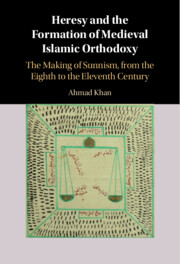 Heresy and the Formation of Medieval Islamic Orthodoxy
Heresy and the Formation of Medieval Islamic Orthodoxy Book contents
- Heresy and the Formation of Medieval Islamic Orthodoxy
- Heresy and the Formation of Medieval Islamic Orthodoxy
- Copyright page
- Dedication
- Contents
- Figures and Tables
- Preface
- Acknowledgements
- Notes on the Text
- Part I History of Orthodoxy
- 1 Introduction
- 2 Discourses of Heresy I (800–850)
- 3 Discourses of Heresy II (850–950)
- Part II Heresy and Society
- Part III Unmaking Heresy: Orthodoxy as History Writing
- Part IV The Formation of Classical Sunnism
- Bibliography
- Index
3 - Discourses of Heresy II (850–950)
from Part I - History of Orthodoxy
Published online by Cambridge University Press: 06 April 2023
- Heresy and the Formation of Medieval Islamic Orthodoxy
- Heresy and the Formation of Medieval Islamic Orthodoxy
- Copyright page
- Dedication
- Contents
- Figures and Tables
- Preface
- Acknowledgements
- Notes on the Text
- Part I History of Orthodoxy
- 1 Introduction
- 2 Discourses of Heresy I (800–850)
- 3 Discourses of Heresy II (850–950)
- Part II Heresy and Society
- Part III Unmaking Heresy: Orthodoxy as History Writing
- Part IV The Formation of Classical Sunnism
- Bibliography
- Index
Summary
This chapter provides a comprehensive examination of how hostility towards Abu Hanifa evolved over three centuries among the proto-Sunni traditionalist network. It argues that the construction of heresy and orthodoxy depended on the circulation of discourses of heresy among textual communities. Transregional proto-Sunni traditionalists developed informal ways to regulate, discipline, and shape conceptions of orthodoxy and heresy. The chapter brings into sharp focus the key agents of proto-Sunni traditionalist orthodoxy: its texts, scholars, and figures who articulated and promulgated discourses of heresy. We can now discern a mature and virulent discourse of heresy among an influential network of proto-Sunni traditionalists seeking to malign, exclude, and marginalise Abu Hanifa and his followers from the proto-Sunni traditionalist conception of orthodoxy. In the tenth century, however, we can observe some attempts by proto-Sunni traditionalists to depart from the network’s emerging consensus and adopt a more accommodating tone towards Abu Hanifa and his followers, which marks the beginning of a broader conception of Sunni orthodoxy.
Keywords
- Type
- Chapter
- Information
- Heresy and the Formation of Medieval Islamic OrthodoxyThe Making of Sunnism, from the Eighth to the Eleventh Century, pp. 38 - 112Publisher: Cambridge University PressPrint publication year: 2023
